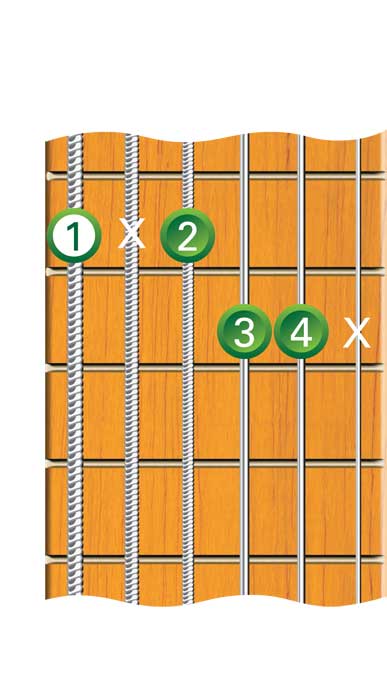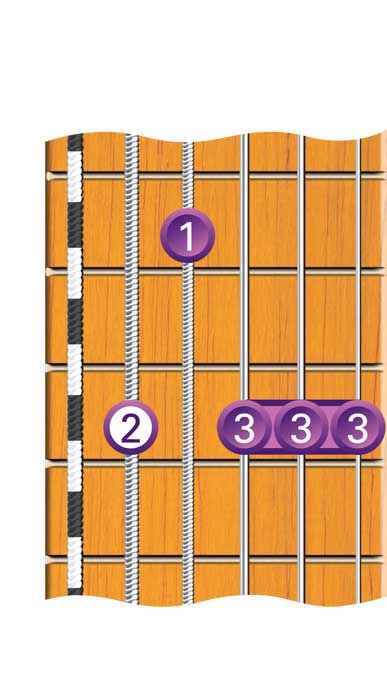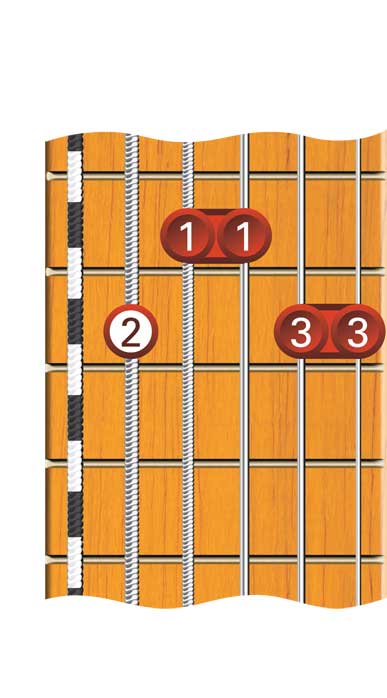
Advanced Jazz Chord Shapes
This lesson covers a selection of interesting Jazz chord shapes that are frequently used in Jazz guitar styles. These chords will be used with many of the chords and fingerpicking techniques that appeared in earlier lessons. Once you are comfortable with the chords in this lesson try creating your own Jazz chord progressions using all the chords throughout this book, applying the fingerpicking techniques you have learned.
Seven Flat Five
The common Jazz chord shapes for the seven flat five chord contain the root note on the 5th and 2nd strings.
(root two)

(root five)

Seven sharp Five
The common Jazz chord shapes for the seven sharp five chord contain the root note on the 6th and 1st strings.
(root one)

(root six)

The following example combines some of these chord shapes as well as some from previous lessons. Ghost notes and the finger roll are also featured.


Minor Seven Flat Five
The common Jazz chord shapes for the minor seven flat five chord contain the root note on the 6th and 5th strings.
(root five)

(root six)

Minor Ninth
The common Jazz chord shapes for the seven sharp five chord contain the root note on the 6th and 5th strings.
(root five)

(root six)

Alternative Bass Notes
Sometimes a chord can be played using an alternative bass note for the root of the chord. These next diagrams highlight two such examples. The first chord, written as Cmaj7/G is a C major seventh chord with a G bass note. The second chord, D7/A is a D seventh chord with an A bass note.
D7/A

Cmaj7/G

The next example uses a variety of Jazz chords including minor ninth, seventh, seven flat five, major seventh, minor seven flat five and seven sharp five chords. The two alternative bass note chord shapes (see previous diagrams) are also used. You may prefer to use finger rolls for most of the following chord shapes.


Seven Sharp Nine
The common Jazz chord shapes for the seven sharp nine chord contain the root note on the 6th and 5th strings.
(root five)

(root six)

Thirteen Flat Nine
The common Jazz chord shapes for the thirteen flat nine chord do not contain the root note. The following diagrams highlight the closest key note as a reference point.
(root five)

(root six)

Some of these chord shapes are used in the following example.




Seven Sharp Five Flat Nine
The common Jazz chord shapes for the seven sharp five flat nine chord contain the root note on the 6th and 5th strings.
(root five)

(root six)

Major Six Add Nine
The common Jazz chord shapes for the major six add nine chord contain the root note on the 6th and 5th strings.
(root five)

(root six)

Augmented Chords
Augmented chord shapes are similar to diminished chords in the same way that each note in the chord can be the root note, therefore each chord shape has three names.
For example, if the first chord on the left is played on the 1st fret, the chord can be named either Gaug (G+), Aaug (A+), or C#aug (C#+). Like diminished chords it is good to use augmented chords based upon one of these root positions (see diagrams).
Augmented (root six)

Augmented (root five)

Augmented (root four)

All of these chord shape types are used in example 193.


